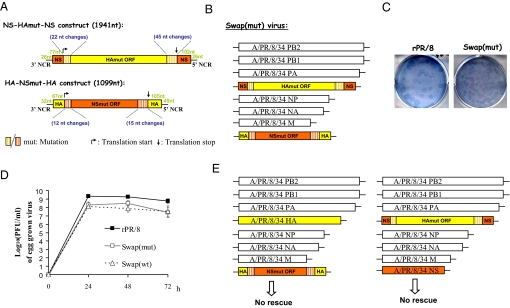Fig. 2.
Generation of the recombinant Swap(mut) virus carrying HA and NS chimeric segments which cannot independently form reassortant viruses. (A) NS-HAmut-NS and HA-NSmut-HA constructs. The strategy was the same as that described in Fig. 1A, except that the ORF region contained serial synonymous mutations: the NS-HAmut-NS construct carried 22- and 45-nt changes at the 3′ and 5′ ends, respectively; the HA-NSmut-HA construct had 12- and 15-nt changes in the NS ORF. (B) Genome structure of the Swap(mut) virus. The genomic composition is similar to that of the Swap(wt) virus (Fig. 1B), except that the NS-HAmut-NS and HA-NSmut-HA constructs were substituted for rescue. [Sequencing the NS-HAmut-NS RNA of the Swap(mut) virus revealed eight A to G mutations in the 3′ end. The sequence of the 3′ end 130 nt of the NS-HAmut-NS RNA is: 3′-ucguuuucgucccacuguuucuguauGaccuagguuugugacacaguucgGGagucgaucuaacgGGagaaaccgaacaggcguuugcucaacgucugguucucgGucguacuuucgcuuGGacaaucaa (capitalized Gs designate the changes observed in virus RNA). For the HA-NSmut-HA RNA segment, two conversions on the NS 3′ ORF region were observed: A122G, which results in a Val to Ala amino acid change; and U318C, which is silent.] (C) Plaque phenotype of the Swap(mut) virus in MDCK cells. (D) Growth rates of the recombinant viruses in 10-day-old embryonated chicken eggs at 37 °C. (E) Failure to rescue two hypothetical reassortant viruses. The experiment on the left used seven A/PR/8/34 plasmids (15, 19, 22) and the HA-NSmut-HA construct, and the one on the right used seven A/PR/8/34 plasmids (15, 19, 22) and the NS-HAmut-NS.

